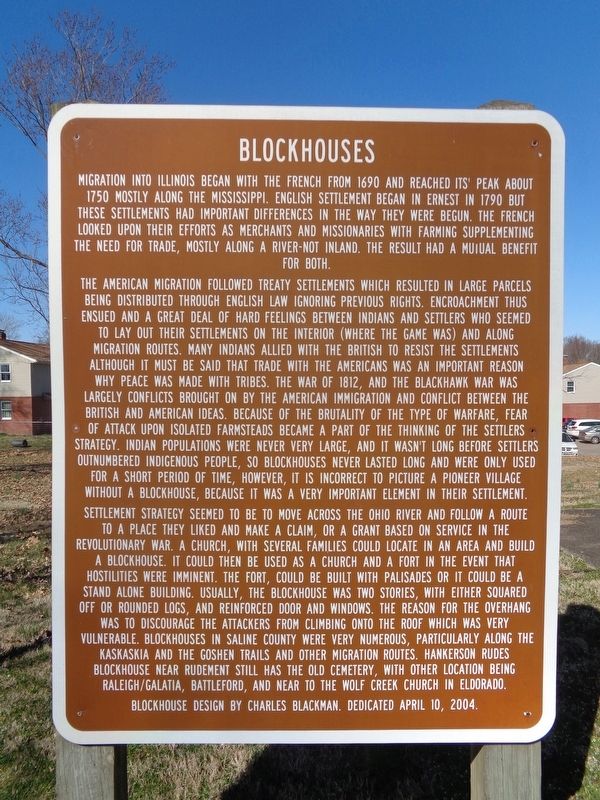Harrisburg in Saline County, Illinois — The American Midwest (Great Lakes)
Blockhouses
The American Migration followed treaty settlements which resulted in large parcels being distributed through English law ignoring previous rights. Enroachment thus ensued and a great deal of hard feelings between Indians and settlers who seemed to lay out their settlements on the interior (where the game was) and along migration routes. Many Indians allied with the British to resist the settlements although it must be said that trade with the Americans was an important reason why peace was made with tribes. The War of 1812, and the Blackhawk War was largely conflicts brought on by the American Immigration and conflict between the British and American ideas. Because of the brutality of the type of warfare, fear of attack upon isolated farmsteads became a part of the thinking of the settlers strategy. Indian populations were never very large, and it wasn't long before settlers outnumbered indigenous people, so blockhouses never lasted long and were only used for a short period of time, however, it is incorrect to picture a pioneer village without a blockhouse, because it was a very important element in their settlement.
Settlement strategy seemed to be to move across the Ohio River and follow a route to a place they liked and make a claim, or a grant based on service in the Revolutionary War. A church, with several families could locate in an area and build a blockhouse. It could then be used as a church and a fort in the event that hostilities were imminent. The fort, could be built with palisades or it could be a stand alone building. Usually, the blockhouse was two stories, with either squared off or rounded logs, and reinforced door and windows. The reason for the overhang was to discourage the attackers from climbing onto the roof which was very vulnerable. Blockhouses in Saline County were very numerous, particularly along the Kaskaskia and the Goshen trails and other migration routes. Hankerson Rudes blockhouse near Rudement still has the old cemetery, with other location being Raleigh/Galatia, Battleford, and near to the Wolf Creek Church in Eldorado. Blockhouse design by Charles Blackman. Dedicated April 10, 2004.
Erected by Saline County Historical Society.
Topics. This historical marker is listed in these topic lists: Forts and Castles • Native Americans • Settlements & Settlers • War of 1812.
Location. 37° 43.143′ N, 88° 33.101′ W. Marker is in Harrisburg, Illinois, in Saline County. Marker can be reached from South Feazel Street just north of Bauman Lane, on the right when traveling north. Marker is on the grounds of Saline County Pioneer Village, near the Aydolette Cabin. Touch for map. Marker is at or near this postal address: 1600 S Feazel St, Harrisburg IL 62946, United States of America. Touch for directions.
Other nearby markers. At least 8 other markers are within walking distance of this marker. River Pirate's Cabin (within shouting distance of this marker); Aydolette Cabin (within shouting distance of this marker); Aydolette Barn and Thrashing Floor (within shouting distance of this marker); Chenault School (within shouting distance of this marker); The Pauper House (within shouting distance of this marker); Cain Church (within shouting distance of this marker); The Poor House (within shouting distance of this marker); Guard and Chossier Salt Kettles (within shouting distance of this marker). Touch for a list and map of all markers in Harrisburg.
Credits. This page was last revised on March 17, 2020. It was originally submitted on March 17, 2020, by Jason Voigt of Glen Carbon, Illinois. This page has been viewed 297 times since then and 21 times this year. Photos: 1, 2. submitted on March 17, 2020, by Jason Voigt of Glen Carbon, Illinois. • Devry Becker Jones was the editor who published this page.

